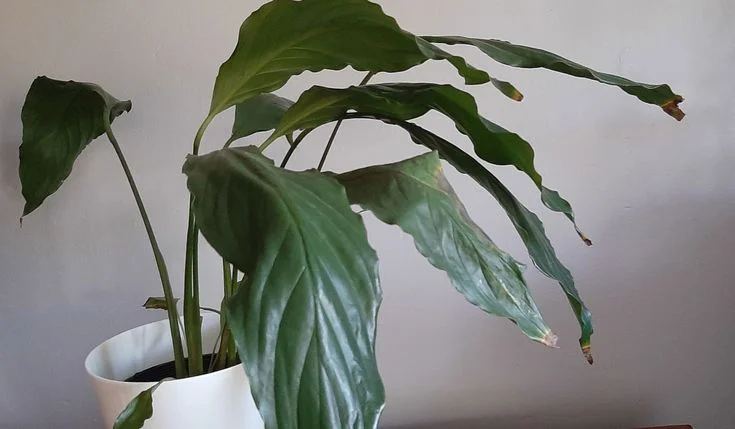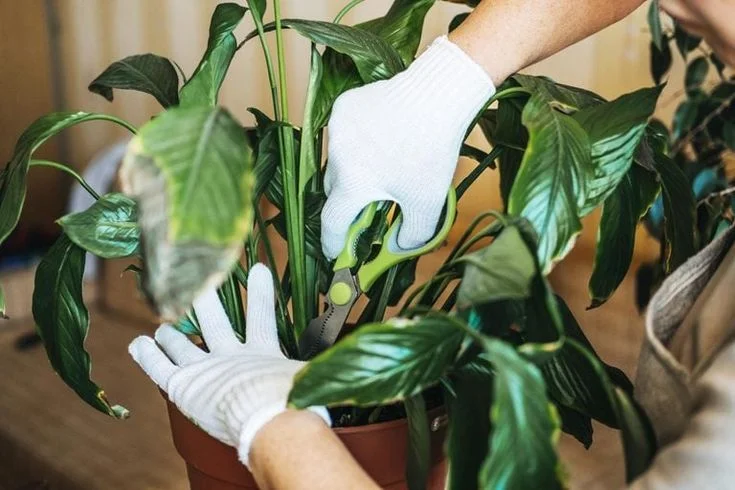Peace lilies are among the most popular indoor plants, loved for their elegant green foliage and stunning white blooms. However, many plant owners often face a common problem peace lily tips are brown. This issue not only affects the appearance of the plant but also signals underlying care mistakes that need attention.
In this detailed guide, we’ll explore why peace lily leaves turn brown at the edges, how to fix the problem, and what preventive measures you can take. By following these expert tips, you’ll ensure your peace lily remains healthy, vibrant, and long-lasting.
Why Peace Lily Tips Are Brown

When you notice that peace lily tips are brown, it usually signals stress caused by improper care. The most common reasons include inconsistent watering, low humidity, excessive fertilizer, or exposure to direct sunlight. Sometimes, poor water quality with high chlorine or fluoride can also damage the plant’s delicate roots, showing up as browning tips.
By identifying the root cause early and making small adjustments such as improving humidity, using filtered water, or providing balanced fertilizer—you can restore your peace lily’s health and prevent further leaf damage.
1. Overwatering or Underwatering
One of the primary reasons peace lily tips turn brown is improper watering. Overwatering can cause root rot, leading to poor nutrient absorption. On the other hand, underwatering stresses the plant, causing its leaves to dry out and develop brown tips.
To prevent this, always check the soil moisture before watering. Ideally, the top inch of soil should feel slightly dry but not bone-dry.
2. Low Humidity Levels
Peace lilies are tropical plants that thrive in high humidity. If the air inside your home is too dry, especially during winter, the peace lily tips are brown because of dehydration.
Placing a humidifier nearby, misting the plant regularly, or grouping it with other plants can improve humidity levels.
3. Excess Fertilizer Use
Fertilizer burn is another common cause of brown tips on peace lily leaves. Over-fertilizing leads to salt buildup in the soil, which damages the roots and leaf edges.
A simple solution is to dilute your fertilizer to half the recommended strength and apply it only once a month during the growing season.
4. Poor Water Quality
Tap water with high chlorine or fluoride levels can also damage peace lilies. These chemicals accumulate in the soil and harm the roots, eventually showing as brown leaf tips.
Using filtered water, rainwater, or letting tap water sit overnight before using can solve this problem.
5. Direct Sunlight Exposure
Although peace lilies love bright, indirect light, direct sunlight scorches their delicate leaves. As a result, the peace lily tips are brown, dry, and crispy.
Always place your plant in a spot with filtered light such as near a north- or east-facing window.
How to Fix Brown Tips on Peace Lily Leaves

If your peace lily tips are brown, the good news is that you can restore the plant’s health with a few simple adjustments. Start by checking your watering routine avoid overwatering, which causes root rot, and underwatering, which dries out the leaves. Instead, water only when the top inch of soil feels slightly dry.
To improve humidity, place a pebble tray beneath the pot, use a humidifier, or mist the leaves regularly. Switch to distilled or rainwater if your tap water contains chlorine or fluoride, as poor water quality often leads to brown tips.
Fertilize sparingly with a diluted, balanced houseplant fertilizer to prevent salt buildup in the soil. Lastly, move your peace lily to a bright spot with indirect sunlight, as direct sun can scorch the leaves. By combining these care steps, you’ll effectively stop browning and encourage lush, glossy growth.
Adjust Your Watering Routine
If your plant is overwatered, allow the soil to dry out before the next watering. For underwatered plants, water deeply until excess drains from the bottom of the pot.
Increase Humidity
Place a humidity tray under your peace lily or use a humidifier to mimic tropical conditions. This small change will help prevent dry leaf tips.
Use the Right Fertilizer
Switch to a balanced, water-soluble fertilizer designed for houseplants. Always flush the soil with clean water every few months to remove excess salts.
Improve Water Quality
If possible, use distilled or rainwater for your peace lily. This simple step ensures healthier leaves and reduces the chances of chemical damage.
Relocate to Proper Lighting
Move your peace lily to a well-lit corner with indirect sunlight. Avoid placing it near harsh windows where the sun can scorch the leaves.
Preventing Peace Lily Tips from Turning Brown

The best way to keep your plant healthy is by preventing peace lily tips from turning brown in the first place. Consistency is key maintain a regular watering schedule, ensuring the soil stays evenly moist without becoming soggy.
To avoid dehydration, provide adequate humidity by misting the leaves or placing the pot on a pebble tray. Always use filtered or distilled water to protect roots from harmful chemicals like chlorine and fluoride.
Fertilize sparingly with a diluted, balanced formula during the growing season to prevent salt buildup that causes leaf burn. Additionally, regularly inspect your peperomia hope plant for pests, as early detection of issues like spider mites can prevent serious damage learn more about signs of spider mites to keep your plant healthy.
Additionally, position your peace lily in bright, indirect light, away from direct sunlight that can scorch the leaves.By following these preventive steps, you’ll not only stop brown tips from forming but also promote lush, vibrant foliage and long-lasting blooms.
Maintain a Consistent Care Routine
Consistency is key when it comes to peace lily care. Keep watering, fertilizing, and humidity at balanced levels to avoid sudden stress on the plant.
Regular Cleaning and Pruning
Dust on leaves prevents efficient photosynthesis and can worsen stress. Wipe the leaves with a damp cloth every few weeks and trim away severely damaged leaves.
Repotting When Necessary
If the roots are overcrowded, the peace lily struggles to absorb nutrients and water. Repotting every 1–2 years in fresh soil keeps your plant thriving.
FAQs About Peace Lily Tips Turning Brown
Q1: Should I cut off brown tips from my peace lily?
Yes, trimming brown tips with sterilized scissors helps improve the plant’s appearance. Cut just above the healthy green part of the leaf.
Q2: Can peace lilies recover from brown tips?
Yes, peace lilies can recover if the underlying issue such as watering or humidity—is corrected in time. However, damaged tips won’t turn green again.
Q3: What’s the best humidity level for peace lilies?
Peace lilies prefer 50–60% humidity. Using a humidifier or pebble tray can easily achieve this range indoors.
Q4: Why do peace lily tips turn brown after fertilizing?
Brown tips after fertilizing usually mean fertilizer burn. Always dilute your fertilizer and avoid overfeeding.
Q5: Are brown tips a sign my peace lily is dying?
Not necessarily. Brown tips are often a sign of stress, not death. With proper care adjustments, your peace lily can bounce back.
Conclusion
If you’ve noticed that your peace lily tips are brown, don’t worry it’s a common issue that can be fixed with the right care. From watering habits and humidity adjustments to fertilizer use and light placement, small changes make a big difference in your plant’s health.
By following these expert peace lily care tips, you can restore your plant’s natural beauty and prevent future browning. Similarly, understanding how to address leaf issues in other indoor plants, like the rubber tree dropping leaves, can give you broader insights into overall plant health and maintenance.
For more in-depth guidance on houseplant care, you can explore trusted resources like the University of Florida Gardening Solutions.
With patience and proper care, your peace lily will continue to reward you with glossy green leaves and elegant blooms for years to come.


















